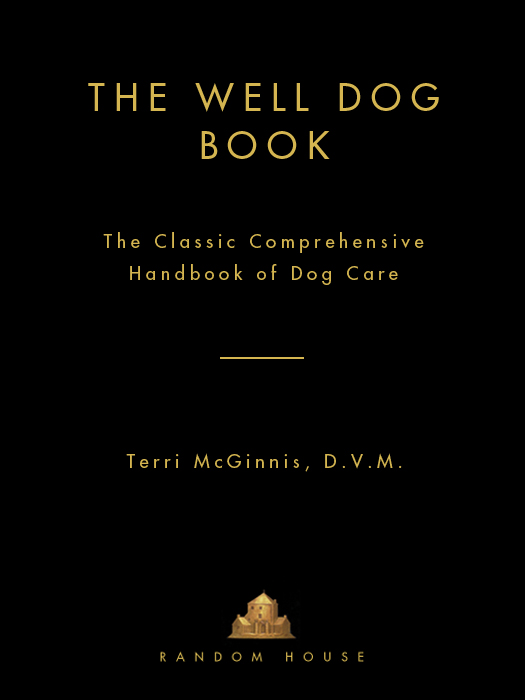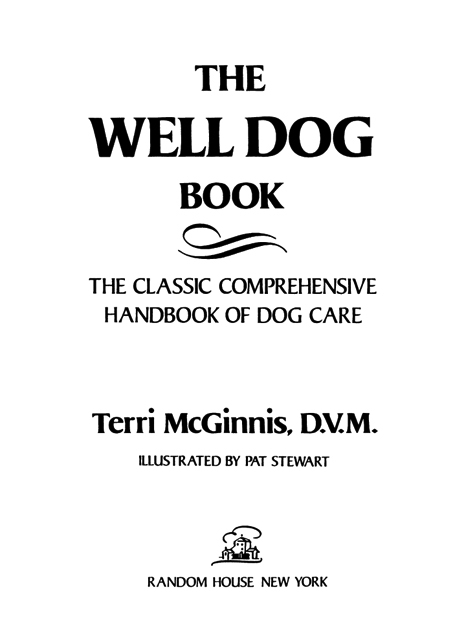Copyright 1974, 1991 by Terri McGinnis, D.V.M. Illustrations copyright 1991 by Pat Stewart
All rights reserved under International and Pan-American Copyright Conventions. Published in the United States by Random House, Inc., New York, and simultaneously in Canada by Random House of Canada Limited, Toronto.
The information in this book, if followed carefully, will enable you to deal with a wide range of dog care problems. However, this book is not designed to substitute for care by a veterinarian, and if you have any questions about whether the advice or procedures in this book are appropriate for your dog, consult your veterinarian.
This work was originally published in hardcover by Random House, Inc., in 1991. It is a revised edition of a work originally published by Random House, Inc., in 1974.
Grateful acknowledgment is made to National Academy Press for permission to reprint two tables entitled Minimum Nutrient Requirements of Dogs for Growth and Maintenance and Required Minimum Concentrations of Available Nutrients in Dog Food Formulated for Growth from Nutrient Requirements of Dogs, Revised 1985 by the National Academy of Sciences; published by National Academy Press, Washington, D.C. Reprinted by permission.
Library of Congress Cataloging-in-Publication Data McGinnis, Terri.
The well dog book: the classic, comprehensive handbook of dog care/Terri McGinnis;
illustrated by Pat Stewart.1st pbk. ed.
p. cm.
ISBN 0-679-77001-1
eBook ISBN: 978-0-307-87469-6
1. Dogs. 2. DogsDiseases. 3. DogsHealth. I. Title.
[SF427.M473 1996]
636.70896024dc20 95-39918
v3.1
CONTENTS
PREFACE TO THE SECOND EDITION
In the many years since the The Well Dog Book was published, veterinary medicine has changed in extraordinary ways. Not only have new illnesses such as Lyme disease (see ) appeared, but medical procedures once restricted to the diagnosis and treatment of human maladies are now commonplace in veterinary practice. Blood tests, urinalysis, radiographs (X-ray pictures), electrocardiograms, computers, and the most modern anesthetics are used daily in animal hospitals around the world. Sophisticated medical equipment such as endoscopes, ultrasound machines, CAT scanners, and magnetic resonance imaging aid in the diagnosis and treatment of conditions as diverse as foreign objects eaten by puppies, heart ailments, and brain tumors. Veterinarians specializing in diseases of the eye or skin, internal medicine, surgery, neurology, emergency care, or dentistry can be found in most major cities. Nevertheless, the core of veterinary medicine remains the same. This new edition of The Well Dog Book reflects these changes in veterinary medicine while still addressing the common problems and concerns of every pet owner.
Although the ability to diagnose and treat disease in dogs is becoming ever more advanced, the dog has basically been unchanged for more than 10,000 years. Despite superficial differences in appearance and behavior between breeds, dogs resemble one another more than they differ, and this book is therefore useful for all types. By learning the basic information contained in this volume and by learning how to use this book as a quick reference, you will be able to be more self-reliant and confident that you are giving your dog the best daily care. The times you will need a veterinarians help will be reduced, and those instances when a visit to a veterinary hospital is required will become less distressing and mysterious. Everyone should have the pleasure of living with a well dog!
INTRODUCING THE WELL DOG
This book is different from other books on dog care because it shows you how to understand the signs of illness or injury your dog may develop and how to evaluate those signs in order to begin proper treatment. In some cases you are advised to seek a veterinarians help. In others you are advised how you can pursue home treatment. Think of this book as a kind of paramedics manual for dogs that will enable you to recognize and treat many health problems on your own. It should help save you money that could be wasted on unnecessary veterinary visits.
This book will help you learn to use your veterinarian as a resource. It is intended not as a substitute for visits to the veterinarian, but rather as a supplement to them. Show this book to your veterinarian as a sign that you are interested in taking an active part in maintaining your dogs health.
This book will help you get to know your dogs body betterwhat about it is normal and what isnt. It will help you understand what your veterinarian is talking about when your dogs health is discussed, enable you to treat some illnesses at home and prevent others, and enable you truly to help your veterinarian get your dog well when the illness is too severe to be treated without professional skills. Ive tried to include the basic things I as a dog owner most wanted to know before I became a veterinarian, and Ive tried to answer the questions dog owners most often ask me about dog health care. Ive tried not to oversimplify things, but in many cases technical information in which I thought the average dog owner would not be interested is not included. Only common problems are covered. If you are interested in details on certain subjects, go to some of the references mentioned or ask your veterinarian for titles of books that might help you.
You dont need any specialized equipment to use this book. Your eyes, hands, ears, and nose, as well as an understanding relationship with your dog, are your most important tools. Dont be afraid to use them. There are more similarities between dogs and people than many dog owners realize. As you read, you will probably find out that you know a lot more about dog medicine than you think you do.
The best way to use this book is to read it through once from beginning to end. In this way you will learn first what is normal and how to take care of a healthy dog, then the things that can indicate illness and what you should do about them. With this first reading you will find out which sections of the book you would like to read again and which sections you will need to refer to only if a specific problem arises. If you want to use this book to learn about a specific problem your dog may have now, look for the problem in the General Index and in the Index of Signs (To learn how to use these indexes, see .)
Anatomy is the place to begin. With this chapter as a guide, you will become familiar with your dogs body. You may wish to refer back to this section when diagnosing signs as well.
Preventive Medicine is a general health care chapter covering important aspects of the daily life of your dog. It and the following chapter have been designed for easy reference by the frequent use of subheads.
Diagnostic Medicine is the heart of the book. Be sure to read enough of this chapter to understand how it is organized and how to use the Index of Signs. Then, when your dog shows a sign of illness or injury, use this section as a guide to your action.
Home Medical Care tells you the basics of home treatment. It includes general nursing procedures and advice on drugs. Since in most cases of illness or injury your dog will need to have some treatment at home, you may want to become familiar with the information in it before beginning to diagnose signs.









